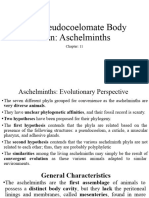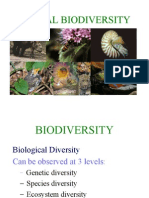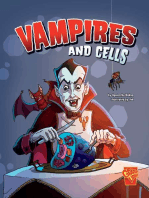0 ratings0% found this document useful (0 votes)
Animal Kingdom: Organ Level of Organisation
Uploaded by
shaunasweeney5144This document summarizes several animal phyla at the organ system level of organization, including platyhelminthes, roundworms, molluscs, and more specifically bivalves, cephalopods, and gastropods. Platyhelminthes are acoelomate bilaterally symmetrical organisms with three tissue layers and organ systems like pharynx and reproductive structures. Roundworms contain a pseudocoelom and can cause diseases. Molluscs have a visceral mass containing organs, a mantle that may secrete shell, and a foot used for locomotion. Bivalves like clams burrow and produce threads, while cephalopods are fast swimmers with closed circulatory systems
Copyright:
© All Rights Reserved
Available Formats
Download as PPT, PDF, TXT or read online from Scribd
Download as ppt, pdf, or txt
Animal Kingdom: Organ Level of Organisation
Uploaded by
shaunasweeney51440 ratings0% found this document useful (0 votes)
This document summarizes several animal phyla at the organ system level of organization, including platyhelminthes, roundworms, molluscs, and more specifically bivalves, cephalopods, and gastropods. Platyhelminthes are acoelomate bilaterally symmetrical organisms with three tissue layers and organ systems like pharynx and reproductive structures. Roundworms contain a pseudocoelom and can cause diseases. Molluscs have a visceral mass containing organs, a mantle that may secrete shell, and a foot used for locomotion. Bivalves like clams burrow and produce threads, while cephalopods are fast swimmers with closed circulatory systems
Original Description:
ppt
Original Title
Animal Kingdom Organ
Copyright
© © All Rights Reserved
Available Formats
PPT, PDF, TXT or read online from Scribd
Share this document
Did you find this document useful?
Is this content inappropriate?
This document summarizes several animal phyla at the organ system level of organization, including platyhelminthes, roundworms, molluscs, and more specifically bivalves, cephalopods, and gastropods. Platyhelminthes are acoelomate bilaterally symmetrical organisms with three tissue layers and organ systems like pharynx and reproductive structures. Roundworms contain a pseudocoelom and can cause diseases. Molluscs have a visceral mass containing organs, a mantle that may secrete shell, and a foot used for locomotion. Bivalves like clams burrow and produce threads, while cephalopods are fast swimmers with closed circulatory systems
Copyright:
© All Rights Reserved
Available Formats
Download as PPT, PDF, TXT or read online from Scribd
Download as ppt, pdf, or txt
0 ratings0% found this document useful (0 votes)
Animal Kingdom: Organ Level of Organisation
Uploaded by
shaunasweeney5144This document summarizes several animal phyla at the organ system level of organization, including platyhelminthes, roundworms, molluscs, and more specifically bivalves, cephalopods, and gastropods. Platyhelminthes are acoelomate bilaterally symmetrical organisms with three tissue layers and organ systems like pharynx and reproductive structures. Roundworms contain a pseudocoelom and can cause diseases. Molluscs have a visceral mass containing organs, a mantle that may secrete shell, and a foot used for locomotion. Bivalves like clams burrow and produce threads, while cephalopods are fast swimmers with closed circulatory systems
Copyright:
© All Rights Reserved
Available Formats
Download as PPT, PDF, TXT or read online from Scribd
Download as ppt, pdf, or txt
You are on page 1/ 24
Animal Kingdom
Organ level of organisation
Platyhelminthes (Flatworms)
Divided into 3 classes; Planarians, flukes
and tapeworms.
Acoelomate.
Bilateral symmetry and cephalisation. Able
to detect or capture prey quickly.
Three definite tissue layers: epidermis,
endodermis and mesoderm
Well-developed organs e.g. pharynx,
eyespots, simple brain, complex
reproductive structures.
Simple nervous system ladder type.
Excretory structures, protonephridia with
specialised collecting cells called flame
cells.
Gastrovascular cavity, often extensively
branched.
Roundworms
Roundworms contain a pseudocoelom
Member of this group cause diseases such
as elephantiasis
Coelom.
A coelom is a body cavity surrounding the
digestive organ or system.
A coelom develops as a cavity within the
mesoderm. It is completely lined with mesoderm.
The organs are held in place by mesenteries.
Therefore more stable and less crowded. Can
become more complex.
The gut is muscular.
It allows organs and body wall to move
independently.
Coelom is fluid filled and this fluid protects
and cushions the internal organs.
Coelomic fluids can assist respiration,
circulation and excretion.
Can act as a hydrostatic skeleton.
Allows animal to change shape.
Molluscs.
Body has 3 parts;
Visceral mass; contains internal organs.
Mantle; may secrete a shell, gills or lungs
development.
Foot; locomotion, food capture or
attachment.
A radula is often present.
Very successful; more than twice the
number of vertebrate species over 110,000
living species.
Most are marine but there are also fresh
water and land molluscs.
Nervous system: several ganglia connected
by nerve cords.
Open circulatory system in most.
Blue haemocyanin.
Some molluscs are slow moving and have
no head; others have a definite head and
sense organs and are active predators.
Bivalves
Clams, oysters, mussels, scallops
Foot is used for burrowing, production of
threads.
Some clams produce a certain type of larva
which is also produced by annelids.
Suggests a relationship between the two
Cephalopods;
Squids, cuttlefish, octopuses, nautiluses
Fast swimming predators.
Closed circulatory system; efficient and
effectively circulates oxygen and nutrients
to body parts.
Gastropods
Snails, whelks, periwinkles, slugs
Garden snails well adapted to terrestrial habitat.
Shell offers protection and prevents drying out
Lubricating mucus makes movement easy.
Has a copulating organ
Hermaphrodite
Mantle becomes a lung
You might also like
- Integumentary System of Invertebrates: Prepared By: Nerizza Anne Q. Lozano100% (3)Integumentary System of Invertebrates: Prepared By: Nerizza Anne Q. Lozano23 pages
- Animal Evolution - The Invertebrates: Chapter 25 Part 1No ratings yetAnimal Evolution - The Invertebrates: Chapter 25 Part 173 pages
- Chapter 11 The Pseudocoelomate Body PlanNo ratings yetChapter 11 The Pseudocoelomate Body Plan39 pages
- BIO 101 Diversity of Animals 5th FEB 2024No ratings yetBIO 101 Diversity of Animals 5th FEB 202431 pages
- Bio f4 Chap 2 Cell Structure and Cell OrganisatioNo ratings yetBio f4 Chap 2 Cell Structure and Cell Organisatio41 pages
- Week 4 - Lecture 2 - AOG - Animal Diversity 1No ratings yetWeek 4 - Lecture 2 - AOG - Animal Diversity 135 pages
- Week 5 - Lecture 1 - AOG - Animal Diversity 2No ratings yetWeek 5 - Lecture 1 - AOG - Animal Diversity 217 pages
- Mollusca, Echinodermata, Hemichordata, ChordataNo ratings yetMollusca, Echinodermata, Hemichordata, Chordata65 pages
- Porifera, Cnidaria, Ctenophora, PlatyhelminthesNo ratings yetPorifera, Cnidaria, Ctenophora, Platyhelminthes63 pages
- Lecture 1&2 - Intro, Protozoa, Por If EraNo ratings yetLecture 1&2 - Intro, Protozoa, Por If Era60 pages
- I.B.Sc - ZoologyEM-18UZO1-Dr.T.PRABU - UNIT - IVNo ratings yetI.B.Sc - ZoologyEM-18UZO1-Dr.T.PRABU - UNIT - IV18 pages
- Phylum Mollusca: Mantle-Is A Dorsal Glandular Fold of The Body Wall. It Is Thick and Muscular and Encloses MantleNo ratings yetPhylum Mollusca: Mantle-Is A Dorsal Glandular Fold of The Body Wall. It Is Thick and Muscular and Encloses Mantle5 pages
- Presentation: Invertebrate Zoology Phylum Arthropoda: Group 2No ratings yetPresentation: Invertebrate Zoology Phylum Arthropoda: Group 230 pages
- Synthetic Biology: Influencing DevelopmentNo ratings yetSynthetic Biology: Influencing Development25 pages
- Are They Acculturating?: Europe's Immigrants and Gender EgalitarianismNo ratings yetAre They Acculturating?: Europe's Immigrants and Gender Egalitarianism31 pages
- Stigma: Ignorance, Prejudice or Discrimination?: References ReprintsNo ratings yetStigma: Ignorance, Prejudice or Discrimination?: References Reprints3 pages
- I Take Harry To The Vet: Rabbit Hamster TurtleNo ratings yetI Take Harry To The Vet: Rabbit Hamster Turtle8 pages
- Capitulo 2 ICHA 2010 - Tablas Perfiles - 2.3.2 Perfiles Europeos Laminados HENo ratings yetCapitulo 2 ICHA 2010 - Tablas Perfiles - 2.3.2 Perfiles Europeos Laminados HE6 pages
- Laparotomy & Laparocopy: Natalie Beatrice Horasia - 01073170054No ratings yetLaparotomy & Laparocopy: Natalie Beatrice Horasia - 0107317005423 pages
- Development of Normal Occlusion: DR - Kapil Saroha BDS, Mds Orthodontics and Dentofacial OrthopedicsNo ratings yetDevelopment of Normal Occlusion: DR - Kapil Saroha BDS, Mds Orthodontics and Dentofacial Orthopedics29 pages
- Malaria Entomology and Vector Control: Guide For ParticipantsNo ratings yetMalaria Entomology and Vector Control: Guide For Participants192 pages
- KUIS Anatomi Sistem Perkemihan + JawabanNo ratings yetKUIS Anatomi Sistem Perkemihan + Jawaban11 pages
- Sokoine University of Agriculture: ClassificationNo ratings yetSokoine University of Agriculture: Classification75 pages
- GOTICO - 1E - Exercise 3 - Integumentary SystemNo ratings yetGOTICO - 1E - Exercise 3 - Integumentary System5 pages
- Classification of Organisms: Appropriate For Grades (5-9) Developed By: Andrew LeechNo ratings yetClassification of Organisms: Appropriate For Grades (5-9) Developed By: Andrew Leech23 pages
- Seafood Report in Q1-2021 - 3mb (2) - IntroNo ratings yetSeafood Report in Q1-2021 - 3mb (2) - Intro12 pages
- Intravenous Fluid Therapy in Adults and Children100% (1)Intravenous Fluid Therapy in Adults and Children16 pages
- 4.3 Susunan Sistem Saraf, Fgs Sinaps & Substansi TransmitterNo ratings yet4.3 Susunan Sistem Saraf, Fgs Sinaps & Substansi Transmitter47 pages
- Balinese-Javanese Cat Breed: TemperamentNo ratings yetBalinese-Javanese Cat Breed: Temperament2 pages
- The False Vampire Bat, Vampyrum Spectrum, in Oaxaca, MéxicoNo ratings yetThe False Vampire Bat, Vampyrum Spectrum, in Oaxaca, México4 pages
- Integumentary System of Invertebrates: Prepared By: Nerizza Anne Q. LozanoIntegumentary System of Invertebrates: Prepared By: Nerizza Anne Q. Lozano
- Animal Evolution - The Invertebrates: Chapter 25 Part 1Animal Evolution - The Invertebrates: Chapter 25 Part 1
- Phylum Mollusca: Mantle-Is A Dorsal Glandular Fold of The Body Wall. It Is Thick and Muscular and Encloses MantlePhylum Mollusca: Mantle-Is A Dorsal Glandular Fold of The Body Wall. It Is Thick and Muscular and Encloses Mantle
- Presentation: Invertebrate Zoology Phylum Arthropoda: Group 2Presentation: Invertebrate Zoology Phylum Arthropoda: Group 2
- Tissues: The Dog Stole the Professor’s NotesFrom EverandTissues: The Dog Stole the Professor’s Notes
- Are They Acculturating?: Europe's Immigrants and Gender EgalitarianismAre They Acculturating?: Europe's Immigrants and Gender Egalitarianism
- Stigma: Ignorance, Prejudice or Discrimination?: References ReprintsStigma: Ignorance, Prejudice or Discrimination?: References Reprints
- Capitulo 2 ICHA 2010 - Tablas Perfiles - 2.3.2 Perfiles Europeos Laminados HECapitulo 2 ICHA 2010 - Tablas Perfiles - 2.3.2 Perfiles Europeos Laminados HE
- Laparotomy & Laparocopy: Natalie Beatrice Horasia - 01073170054Laparotomy & Laparocopy: Natalie Beatrice Horasia - 01073170054
- Development of Normal Occlusion: DR - Kapil Saroha BDS, Mds Orthodontics and Dentofacial OrthopedicsDevelopment of Normal Occlusion: DR - Kapil Saroha BDS, Mds Orthodontics and Dentofacial Orthopedics
- Malaria Entomology and Vector Control: Guide For ParticipantsMalaria Entomology and Vector Control: Guide For Participants
- Classification of Organisms: Appropriate For Grades (5-9) Developed By: Andrew LeechClassification of Organisms: Appropriate For Grades (5-9) Developed By: Andrew Leech
- 4.3 Susunan Sistem Saraf, Fgs Sinaps & Substansi Transmitter4.3 Susunan Sistem Saraf, Fgs Sinaps & Substansi Transmitter
- The False Vampire Bat, Vampyrum Spectrum, in Oaxaca, MéxicoThe False Vampire Bat, Vampyrum Spectrum, in Oaxaca, México





























































































